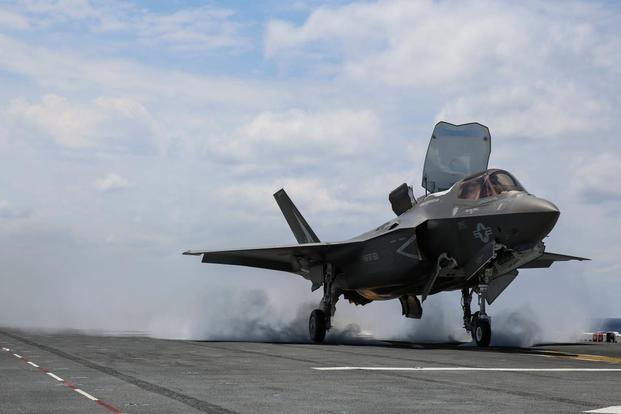FARNBOROUGH, ENGLAND -- For those who work on the Marines' cutting-edge fifth-generation fighter, maintenance has gone high-tech.
In addition to the hands-on tasks of adding fuel and repairing and replacing components, the maintenance team for the F-35B deals on a daily basis with the aircraft's Autonomic Logistics Information System, or ALIS -- Lockheed Martin's custom-built software that purports to self-diagnose problems, assist with mission planning, and track upkeep down to the component level.
Master Sgt. Alan Proctor, maintenance chief for the F-35 detachment of VMX-1, the Marines' Yuma, Arizona-based test and evaluation squadron, told Military.com that working with ALIS means a change in workflow, and more time spent on the computer than in his previous role as a maintainer for Bell UH-1 Huey and Cobra helicopters.
"Once I get into ALIS, it will help me document all the maintenance that was done to it; it will help me debrief maintenance from the last flights. I use it to check my tools in and out from the tool room ... so it's really one-stop shopping," Proctor said. "It's also in its very beginning stages where it needs user input to help streamline it so it can get better."
On a daily basis, and sometimes more frequently, Proctor said, personnel from the squadron exchange emails with Lockheed Martin engineers to troubleshoot potential problems and get parts maintenance questions answered.
"With legacy systems that have been around forever, they've already documented how much damage limitations you can have on a certain area of the aircraft. But this one here, they haven't done the examination on every single component and item all the way to that level. … We're always wondering, 'Is this good, yes, or does it bear scrutiny and I need to do something to fix it,' " he said.
ALIS has been the subject of much public criticism, with a history of software bugs that confused maintainers and made it difficult to use. An April report from the Government Accountability Office also raised fears that the F-35 is so dependent on the system that a long-term outage could ground the fleet.
Officials with the F-35 Joint Program Office have maintained that none of ALIS' capabilities are combat-critical.
Proctor acknowledged that the aircraft does often generate false-alarm health reporting codes.
"Sometimes you have a check engine light that goes on and there's nothing wrong with the car, you have to reset and go 'oh, yeah, I had a momentary hiccup,' " he said. "It's new and they're trying to find out what the acceptable threshold should be over the lifetime of the aircraft. I would say that some of the parameters that we're looking at are set at a very low tolerance. SO if something appears to be abnormal, we catch it early, look at it and find out, is it really abnormal or pop that code, look at it, or everything's fine."
But Sgt. Benjamin McIntyre, who worked as a Harrier mechanic and then helped to stand up the Marines' first operational squadron of F-35Bs, VMFA-121 before joining VMX-1 in 2014, said the software is causing fewer headaches for personnel now than when he was introduced to it.
"ALIS, she's still young, but over the past five years of being in the program, she's matured a lot," McIntyre said. "When we first got ALIS, she was still very, very slow, and up to this day she has improved significantly and is much faster. We're not losing as much man hours at work."
For Chief Technician Phil Collins, a member of the United Kingdom's Royal Air Force attached to VMFAT-501, the Marine's F-35 pilot training squadron in Beaufort, South Carolina, ALIS is an exciting leap forward in maintenance. Collins expects to return to the U.K. around 2018, when the first British squadron of F-35B jets is set to stand up.
"The end of the day, you'll never get rid of an engineer on the ground, looking at an aircraft physically," he said. "But with the engineering advances we have with this aircraft and ALIS, that [maintainer] is so much further along than a guy just looking at an aircraft, saying 'Oh, is it leaking or not, I don't know.' "
-- Hope Hodge Seck can be reached at hope.seck@military.com. Follow her on Twitter at@HopeSeck.
Related video:






























